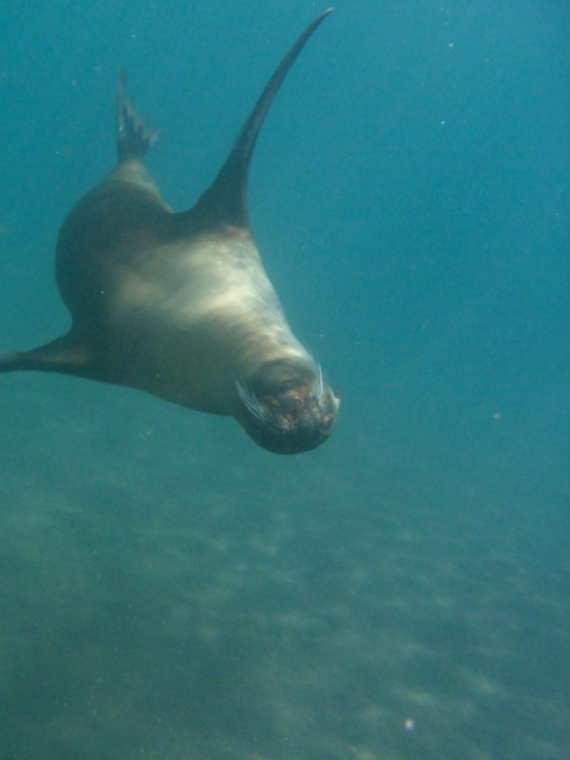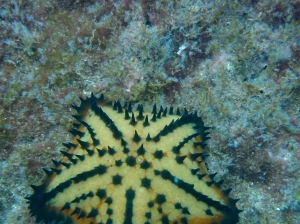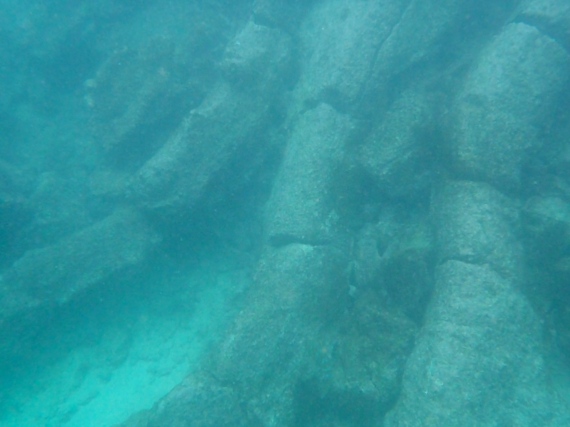It was cloudy and misty on Friday morning. No surprise, but still not our ideal weather for sightseeing. We started the day with a hike along the red-sand beach and a very short way inland to a lagoon. The red sand beach was really cool. It was littered with starfish skeletons and sea lions, but it was the texture and color of the sand itself that was most strange. Looking at it, it looked exactly like mud–dirty, gritty, and smelly– but then as you walked on it you found that it was only sand.
Our guide, Johan, was very talkative when it came to discussing all the different animals. At first I was worried that the trip would be all talk and not any exploration. Learning about things is good, but I can do that from a book. Later that night, Johan told us about the larger cruise ships that come here with 40 to 100 people. These tend to attract older people who don’t have enough energy for three hours of hiking and three hours of snorkeling each day. Working on these ships is the premier job
for naturalist guides in the Galapagos (and being a guide is the best job to have overall), but they have to have really good English and talk a lot to compensate for the activities. My fears were unrealized, though. In fact, there was a lot of talking and a lot of exploring.
The geography of Rábida Island was mildly interesting, but it wasn’t anything I hadn’t seen before. A red sand beach played host to lazy sea lions. Behind the beach was a salt-water lagoon where you could see a range of birds. The rest of the island wasn’t accessible by hiking trails. The terrain was hilly and covered with dry-zone vegetation.
Although the hike was somewhat short, there was a lot to see. Aside from the sea lions, we saw the typical smattering of pelicans, marine iguanas, and blue-footed boobies, especially a little ways down the beach where there were some low cliffs. Also trolling the beach were the American Oystercatchers with their bright reddish-orange beaks. Although these birds are not all that common here, we saw four or five of them throughout the trip, usually in pairs. When we cut slightly inland to the lagoon, we saw a male Vermillion Fly Catcher, which surprised me because they usually inhabit the highlands, not the dry zone. The most exciting spotting I had that morning, though, was the Galapagos hawk. Even in a place like the Galapagos, with wildlife in abundance, I expected raptors to be well hidden, or at
least far away from footpaths–perhaps in a tall tree. No, this hawk was walking along the ground just a few meters from us. The typical image of a hawk is either something perching in a branch looking for prey, or swooping down to scoop it up with its sharp talons. This one was waddling along the ground.
The next activity was snorkeling. Johan downplayed the snorkeling at Rabida, “”It’s not the best but it’s still good”) but I thought it was pretty good. My favorite part of the snorkeling was all of the starfish. Not only where there four or five species, all in different colors and shapes, but even within one species they showed brilliant variation. During our afternoon snorkel at Bartolome we also saw many starfish, more than I’d remembered in the past, including the Panamic cushion star (Pentaceraster cummingi) at Bartolome. These starfish have so many different color phases I mistook them for separate species at first. Most of them have some sort of lattice pattern of dots on the dorsal side that can range from bright orange to red, to a deep blue. Usually the tips of the five arms are tinted differently than the rest of the body, sometimes brighter and sometimes darker.
Other starfish species we saw hardly had a central core at all, just five tubular arms radiating from a point. I saw one that was bright lime green, and another that had bands in three different shades of blue.
And then there are the chocolate-chip starfish. These are slightly smaller overall, with shorter arms and larger discs than the others. They are yellow, or sometimes greenish and are covered in little pointed black lumps that look like chocolate chips.
All of these starfish weren’t the only things to see, though they were the most colorful, complemented by small beds of anemones and coral: a pair of white-tipped reef sharks patrolled the area. We had nothing to fear though, these are friendly bottom-feeding sharks. In fact only about 10 percent of the world’s shark species are potentially dangerous, and only about 7 percent have been known to attack humans.
Everyone except me saw a giant manta ray swim by. I was too busy taking my time, or perhaps investigating a little glowing speck of plankton I found. Have you ever heard of the certain species of tiny planktons than glow when they are disturbed by waves, or perhaps a boat or swimmer. I think I found one of these that had been separated from the rest of its kind. If I swished my hand through the water I could make it glow.
Usually I get extremely cold while snorkeling. I still got a little cold during the snorkeling trips on the cruise but
not nearly as much. Part of this is because the farther north you go, the warmer the water gets because you get farther away from the cold Humboldt current. Mostly though, it was because I paid $10 to rent a wetsuit. It was one of my best ideas.
Soon after we finished the snorkeling the clouds, which had graciously dissipated for our water activity came back. It was okay, though, because it was time for lunch, and a two hour journey to the next island: Bartolome.
On the way there, we had time to relax and warm up with hot chocolate and snacks. Some people took a nap, others sat out on the deck. The second half of the trip to Bartolome was quite scenic because we followed the southern coast of Santiago Island,
which had many volcanic formations and lava flows visible from its last eruption at the beginning of the 20th century. These eruptions actually led to the island increasing in size quite noticeably. On the way to Bartolome we were also followed by a troupe of frigate birds. They hovered over our boat, and sometimes fought eachother in the air, only a few meters above our heads.
The first activity of the afternoon was snorkeling again. We couldn’t go until mid-afternoon due to permit constraints, but in the meantime we got to relax on the beach. Techincally it was optional, but our entire group decided to go. Ashley, Kaitlyn, Luke, and I ended up playing Euchre until it was time to get in the water.
We went snorkeling at the same place as during my first visit to Bartolome–right along the shore around Pinnacle Rock (a large pillar towering out of the ocean)–but for about twice as far. The pangas took us out a ways, and we snorkeled back to the beach.
The snorkeling wasn’t as amazing as I had remembered it being the first time I went to Bartolome, but there was still plenty to see.
I already mentioned all the colorful starfish. That was the most of what there was to see for animals during the first part of the snorkeling. Some people who were swimming a bit farther from the shore saw a Galapagos shark, and were able to call the rest of us over to see it. There were some interesting lava tunnels that snaked down from the shore, looking like giant buttress roots, or perhaps the ancient Gothic architecture of Atlantis.
As we approached Pinnacle Rock, the animals began to get a bit more diverse. A couple of penguins were swimming along, as well as a large stingray, rippling its body to smoothly glide across the bottom. When I am snorkeling, I always make sure to look above the water from time to time. Part of this is to help keep myself oriented so I can stay with the group and not get too close or too far from shore. Another part, though, is that there can be a lot to see on land. Many birds will let you get closer to them when you are swimming than you could on dry land, but you won’t see them if you keep your head down all the time.
On one of the times I’d surfaced I was right by Pinnacle Rock, and I heard a loud splash not too far from me. I wondered if something had fallen off the cliff. I didn’t see anything until I went back to snorkeling when I saw a giant column of bubbles slicing into the water three or four meters deep. It turns out a blue footed booby had seen something it wanted to eat and dove into the water right near me. I wish I had realized what had happened earlier so I could have had my camera ready. Not so much for the dive–that would have been impossible– but for the bubble contrail the booby left in its wake.
We finished the snorkeling back at the beach. We were snorkeling around low tide, and it was surprising how much had changed compared to snorkeling at high-tide during my first trip. Rocks that we could easily swim over were now two feet out of the water.
The last activity of the day was to take a hike up Bartolome to look at the landscape, but before doing that we took a little panga ride to see the penguins perched on the rocks. This would be the first and only time we would see penguins, since they stay away from the warmer waters in the north. Johan wasn’t too talkative on the hike. He admitted later that geology doesn’t really interest him–not like the animals do. The biggest animals on Bartolome are lava lizards not much bigger than your finger.
I enjoyed the hike though, especially the way down when the evening sun bathed the barren landscape in the warm orange light that is only possible an hour or two before sunset. The cruse was going by so fast, but we were so glad to be there.
That evening was the most social evening of the trip. The first evening nobody really knew eachother, and the third evening we had to leave early which meant the boat was rocking too much to sit and relax. Even though it was the halfway point of our trip, there was a “Welcome Party” scheduled for the early evening. I’m not exactly sure what was planned for this party. Sean told us that during the welcome party for the southern island cruise they all got free piña coladas. This time, it seemed to be the passengers that threw the welcome party. We all sat on the deck into the evening chatting and drinking rum and coke that various people had provided. It was great fellowship. Sean and I bonded over traveling in Africa, I tried my best to explain the story of Darwin to Fergus and Lena. Even some of the crew members came and sat with us, though they pretty much talked amongst themselves.
I think this is mostly because of the language barrier. Although pretty much everyone on the boat knew some words of Spanish, and some of the passengers were quite fluent, English was clearly the lingua franca. It was so strange to go three days without using Spanish at all. It was easy to forget I was in Ecuador at all!
This was also the only night that Johan really interacted with us in the evening. It was really interesting to hear him talk about some local history, what it takes to become a guide in the Galapagos, and other questions. He was also curious to know what sorts of things the three of us did at the station. (He found out we worked there on the first day. As we were on the bus to the highlands on Santa Cruz, he asked us if we had visited the Charles Darwin Station. “We live there,” Kaitlyn blurted out. It took Johan a couple seconds, and a drink of water, to recover from that unexpected answer. I wonder what sorts of first impressions it made with the other people on the cruise.) Aside from the sightseeing, this was the highlight of the cruise.
I stayed up until the boat started moving. At this point, Kaitlyn was still pretty much sleeping constantly as a combined side effect of anti-seasickness medication and avoidance of being awake on a boat. Luke and Ashley were virtually glued together the entire trip, and they both went to bed a little earlier too. We left around 10 pm, since it takes eight hours for the boat to travel from Bartolome to the next island, Genovesa. I didn’t have any trouble falling asleep, though I did wake up a few times during the night. The first time I woke up was around midnight. This one was planned, though. Johan told us that right around midnight we would be crossing the equator and that there was a decent chance of seeing and hearing dolphins jumping. When he told us this, we started joking around that as the dolphins jumped there would be rainbows coming out of their tails, and flying unicorns and every other magical thing as we cross the center of the world right at midnight.
It didn’t live up to the hype though. I got up at 12:06, walked around, saw nothing and went back to bed. I think Sean and Vlad had already gone back to bed by the time I got up. Even before I got out of bed, I realized that we had left an hour late, so we probably wouldn’t be crossing the equator for another hour anyhow. Oh well. At this point the seas were starting to get rougher, to the point that it wasn’t any fun to try to stand up on the boat. I went back to bed and didn’t leave it until we had dropped anchor in Darwin Bay on Genovesa Island.











